How to Grill Shrimp: Thermal Principles and Key Temperatures
Grilled shrimp is one of the delights of summer. They dress well in fresh, light flavors and don’t weigh you down quite as much as, say, pulled pork, meaning you can garden, hike, or whatever it is you do in the summer, without feeling sluggish.
Of course, shrimp do have problems on the grill. You want that grill-y Maillard-reaction flavor, but you also don’t want the little guys to overcook and turn rubbery. Shrimp that have that *snap* to them—that are juicy and tender—are hard to get right unless you use some thermal thinking and a little bit of science. The key: using large shrimp and cooking them to the right temperature! We recommend a shrimp cook temp of 135–140°F (57–60°C) for optimal juiciness, and with a fast and accurate Thermapen® ONE, you can hit that temperature far better than by simply eyeballing it. Read on for more details on perfecting grilled shrimp!
Get the temperature tools for this post here:
Use Large shrimp for Grilling
Using the biggest shrimp you can get hold of is the first defense against rubbery, overcooked crustaceans. For grilling, try to never use anything smaller than 15-20 size shrimp (meaning there are between 15 and 20 shrimp per pound). The larger mass and size will act as a bit of a buffer against overcooking, giving you time to get those tasty grill lines on the outside. Also, use peeled shrimp. There’s not much use getting beautiful grill lines on your shrimp and then peeling off and discarding those lines.
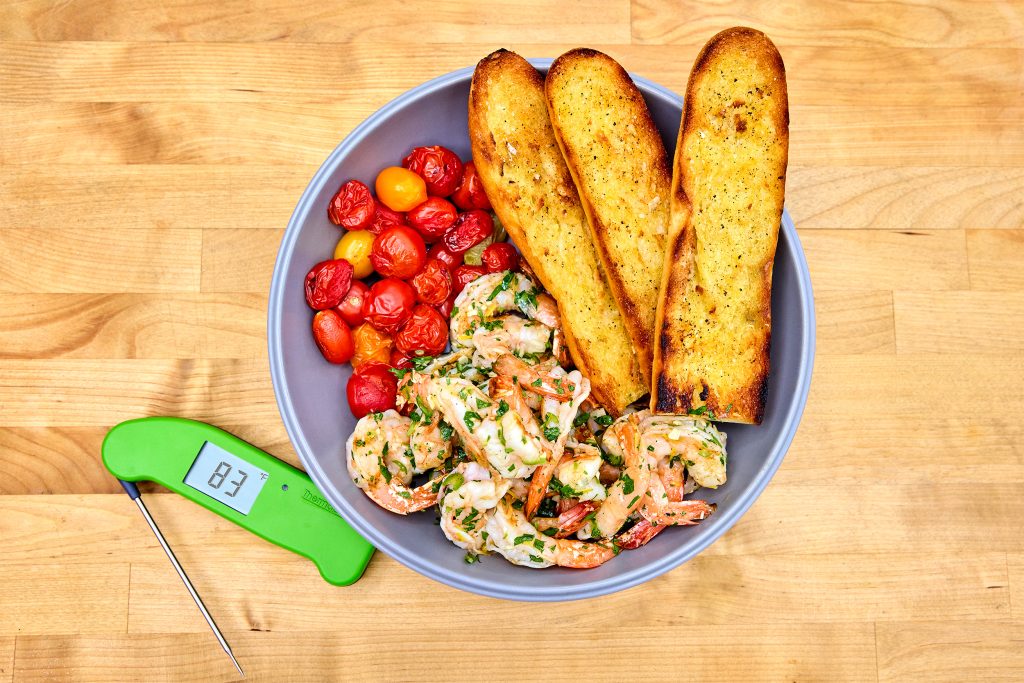
Use Sugar When Grilling Shrimp
If you want that grilled, charred flavor on your shrimp, it’s going to need a little help. With a final shrimp cook temperature of only 135–140°F (57–60°C), you don’t have a lot of time on the grill to char things up before you hit your pull temp (a fact compounded by the small size of shrimp). A cheat to get around the slowness of the Maillard reaction is to introduce a little bit of sugar to the equation. No, we’re not sweetening the shrimp, just giving them a little help with browning/ caramelization. (If you’re thinking that Maillard-browning and caramelization are two different processes, you are correct. However, the complex flavors that arise from both of them are similar, they just have a different chemical mechanism for getting there.) Tossing your shrimp with a little bit of sugar will help them brown without making a noticeable flavor difference.
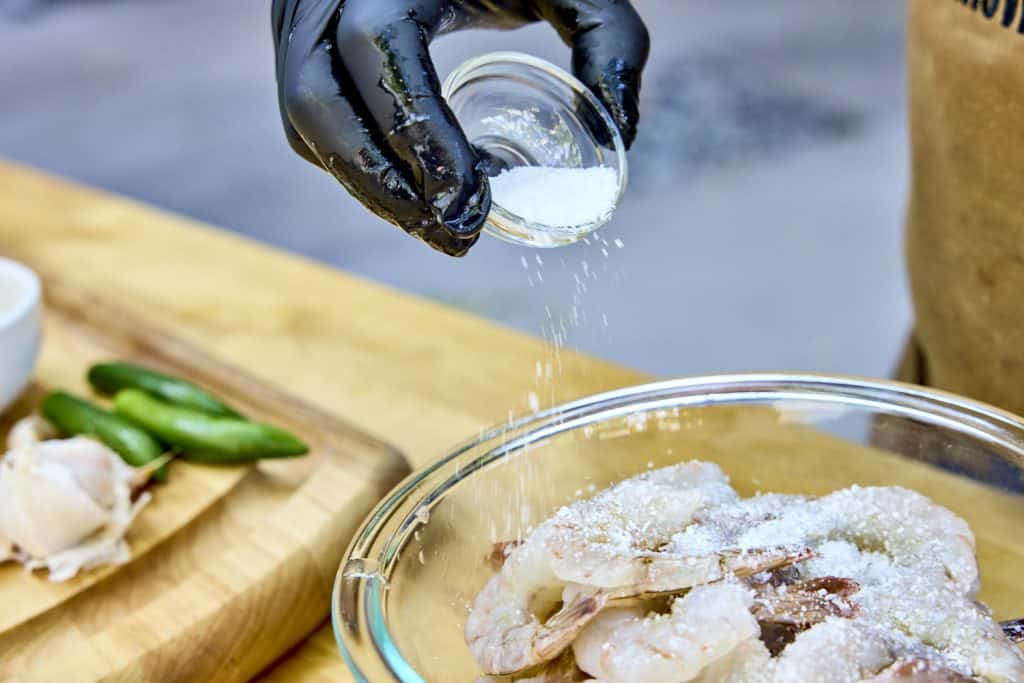
Baking Soda for Better Browning
Another way to cheat the browning process is to raise the pH of your food. Protein browning happens more readily, as does caramelization, at a higher pH, meaning that the same shrimp internal cook temperature can do more browning work with higher alkalinity. Adding a very small dose of baking soda raises the pH to help the added sugar, as well as the natural proteins, brown up faster without having to get as hot. (Incidentally, this is a great trick for caramelizing onions, too. A little sprinkle of baking soda brings about a much faster browning process.)
Pack Shrimp Tightly on Skewers Before Grilling
An individual shrimp sitting on a grill grate faces two serious dangers: it will probably fall through the grate, and if it doesn’t it has a very high probability of overcooking. After all, it’s just one tiny shrimp sitting there, surrounded by flame. (Have I mentioned yet that shrimp are easy to overcook on the grill?) To overcome both these hurdles, we need to think about how we situate our shrimp, and it turns out we should do it like sardines.
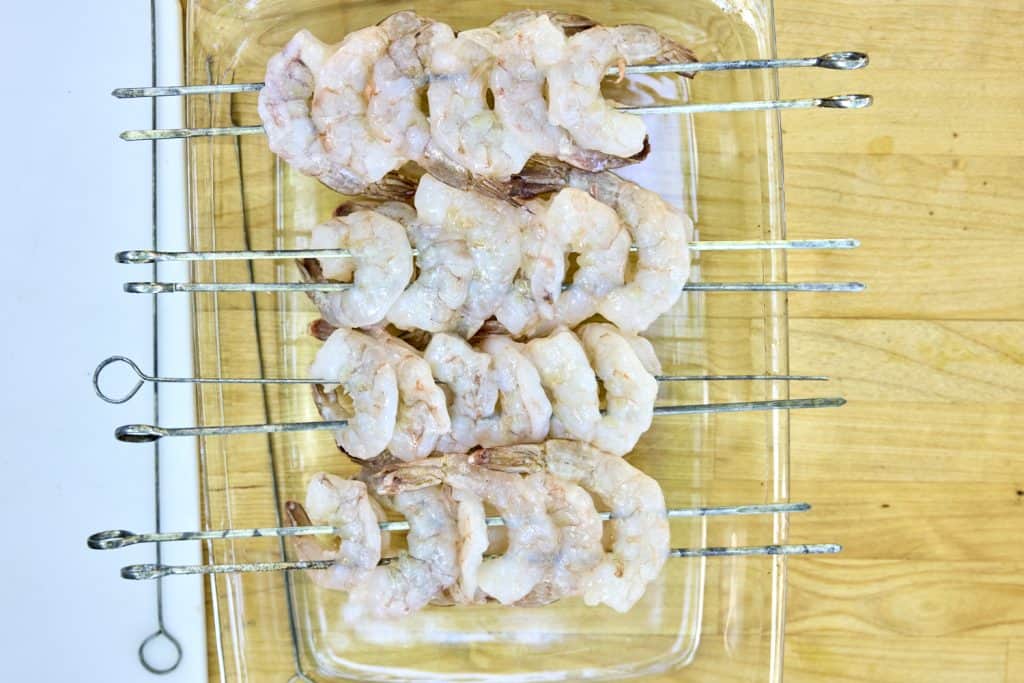
To get the best thermal situation for grilling shrimp, use two skewers and pack the shrimp tightly against one another with no gaps between them. Stagger the direction the shrimp face so that they stack well. By stacking them close together, we eliminate surface area that would be exposed to heat, we transform individual shrimp into a broad flat block of shrimp that will allow the heat to penetrate it more slowly. And because of the two skewers, that swath of shrimp easily be maneuvered and flipped without than flopping around, spinning on a single-skewer axle and falling through the grates.
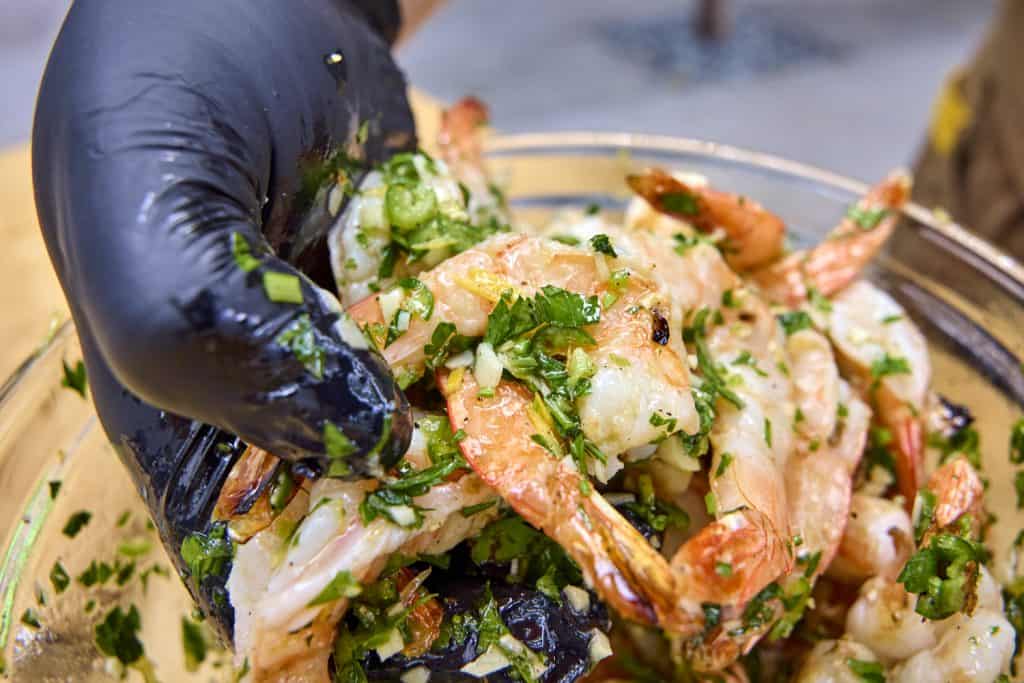
Drier Shrimp Grills Better
Here’s a thermodynamic fact: water takes a lot of energy to convert to steam. And here’s a chemical fact: Maillard browning doesn’t happen well in the presence of excess moisture. So what happens if you put dripping wet shrimp on the grill and hope to get nice browning? You have to wait while the water boils off before browning begins, and you overcook the shrimp—heat is still going into the shrimp while you’re boiling the water off the surface, after all.
To ensure a faster sear, pat your shrimp dry with paper towels (preferably before mixing in the sugar and baking soda), then let them air-dry in the refrigerator for an hour before grilling. Suspending the skewers above a baking dish will provide all-around air circulation, drying the shrimp faster and better. After an hour of drying in the fridge, your shrimp are much more likely to sear well without overcooking.
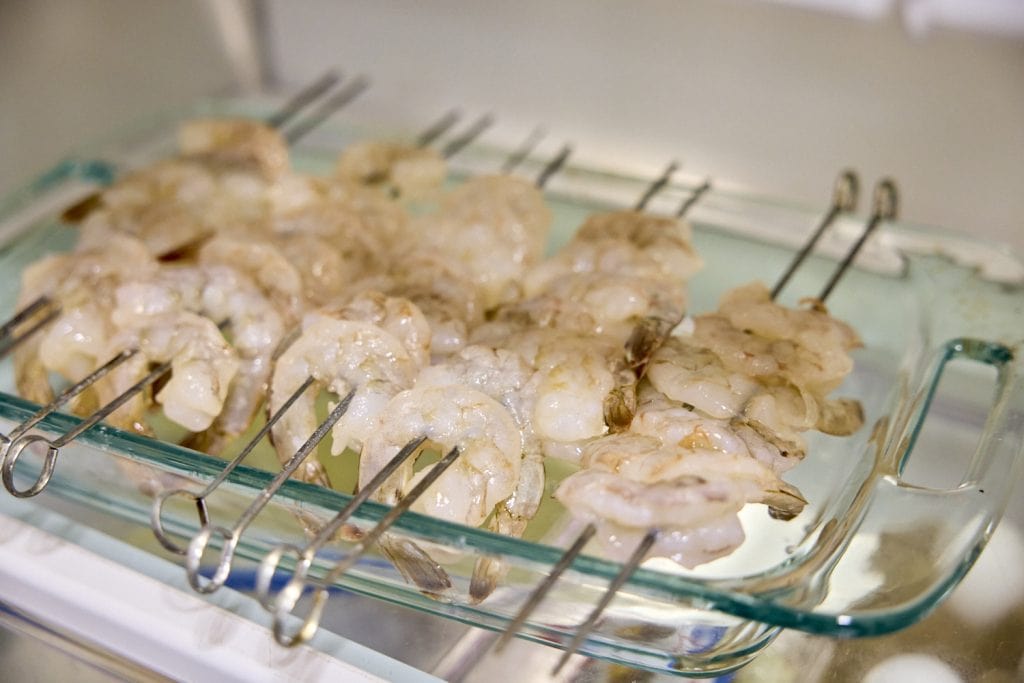
Oil baste
But what if you want to add flavor to your shrimp before cooking? Our desire for drier-skinned shrimp precludes a wet marinade. The answer is oil. Some minced garlic mixed in with some oil and brushed onto the shrimp before grilling can bring loads of flavor to the dish and, as a bonus, the oil actually helps the shrimp to sear on the grill grates. A plain, neutral flavored oil will do fine, but olive oil or a flavored oil like a chili or lemon oil can add another dimension to the final dish.
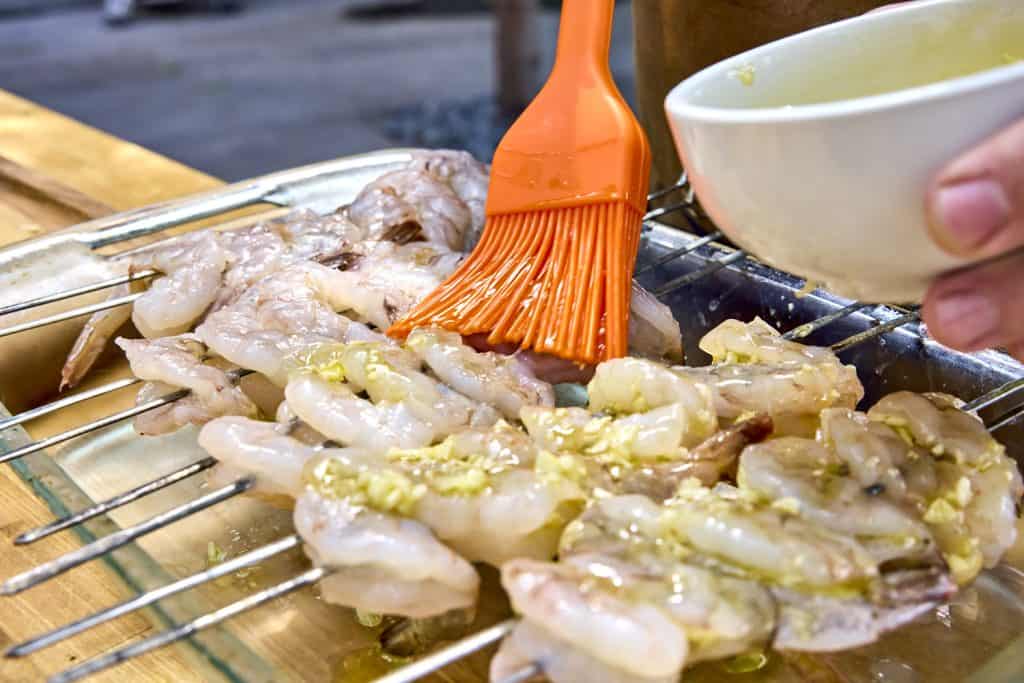
Cook Shrimp on a Hot Grill to an Internal Temp of 135–140°F (57–60°C)
To get a fast, hard sear on your shrimp, you’ll need a hot, hot grill. If you’re using a charcoal grill, pile up a full chimney of hot coals under one half of the grill and cook over those coals. If you’re cooking with gas, turn your burners to full and let the grill heat up for at least 15 minutes before you cook (while your shrimp are drying in the fridge).
Brush your shrimp with oil and garlic, and toss the double skewers onto the direct heat. Let them stay on that first side for a solid 2–2 ½ minutes, then flip. Start checking the shrimp cook temperature with your Thermapen ONE immediately, looking for a pull temperature of 130–135°F (54–57°C). Total cooking time will be about 5 minutes. As each skewer reaches temp, pull it from heat and set it aside on a clean platter.
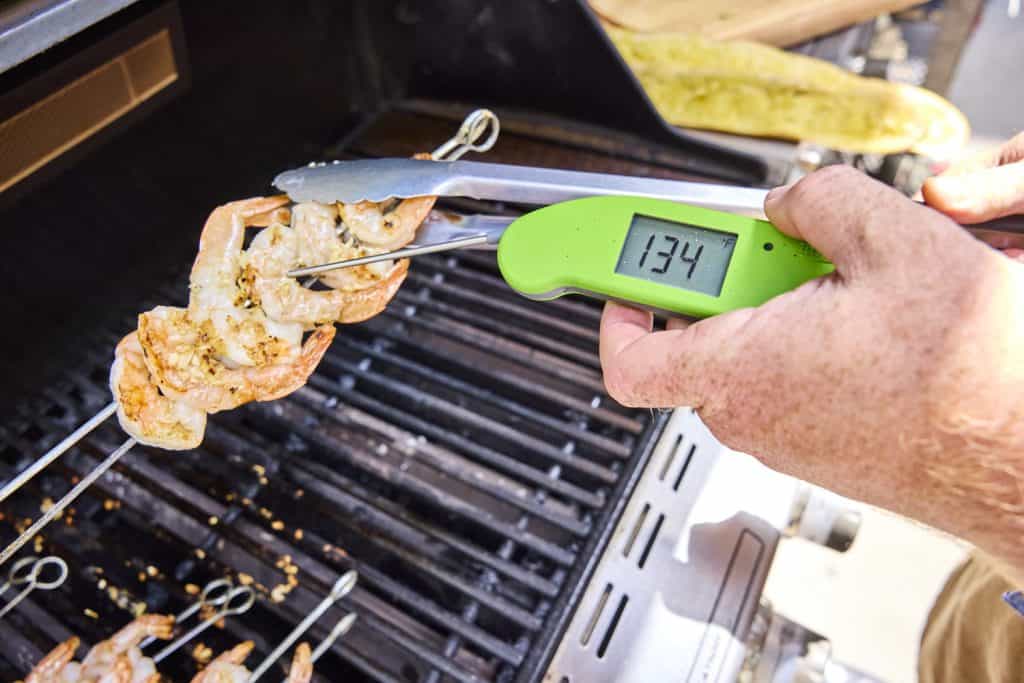
(Note: the USDA lists 145°F [63°C] as the “safe” temperature for shrimp. If you have a weakened immune system or are easily susceptible to food-borne illness, consider cooking your shrimp to this temperature.)
Serving
If you are impatient or not trying to impress anyone, you can serve those shrimp right now and they’ll be great. But if you really want the best, you need to dress them after you cook them. We denied the shrimp a wet rub before grilling on the basis of needing more char, but now that they’re off the heat,
Grilled shrimp are so tasty, especially when they’re cooked correctly, and this easy, incredible recipe will show you that cooking them properly isn’t even very hard! With the aid of your Thermapen ONE and some good thermal thinking and a few cheats, you can get delicious, fire-kissed shrimp that will make a serious impression on your tastebuds and your family. So throw another sea-going invertebrate on the grill, friend, and happy cooking!
Print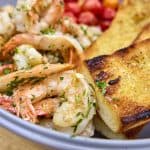
Grilled shrimp recipe with grill-toasted garlic bread
Description
Amazing, succulent grilled shrimp with grilled garlic toast, adapted from Grilled Shrimp With Garlic and Lemon on SeriousEats.com
Ingredients
For the shrimp
- 2–2 ½ lb large shrimp (15–20 size), peeled and deveined
- ½ tsp baking soda
- 1 Tbsp kosher salt, plus more to taste
- 1 tsp sugar
- 6 medium cloves garlic, minced, divided
- ½ C extra-virgin olive oil, divided
- 1 fresh hot chili, finely diced (optional, but very tasty)
- 1 tsp zest and 4 tsp juice from 1 lemon
- 3 Tbsp minced fresh parsley leaves
- Freshly ground black pepper
For serving
- 1 baguette, split lengthwise
- 5 Tbsp olive oil, divided
- 8–10 large cherry tomatoes
- 1 large clove garlic, split lengthwise
- Kosher salt and black pepper
Instructions
Prepare the shrimp
- Drain the shrimp well and dry them off lightly with paper towels.
- Toss the shrimp in a bowl with the sugar, baking soda, and salt.
- Skewer the shrimp on a few sets of 2 skewers. Alternate the direction they face, head/tail/head/tail. Skewer them close together to create a solid sheet of shrimp between the two skewers.
- Suspend the skewers of shrimp over a baking dish so that air can flow freely above and below them.
- Let the shrimp dry out in the refrigerator, uncovered, for an hour. They should feel quite dry to the touch.
- While the shrimp dry, mix half the olive oil with half the minced garlic. Set aside.
- Also mix together the parsley, lemon zest and juice, diced chili, remaining garlic, remaining olive oil, and salt and pepper to taste.
- Preheat the grill.
Prepare the sides
- Prepare the bread by brushing the cut face with 3 Tbsp olive oil, sprinkle it lightly with salt and pepper.
- If your tomatoes are large enough to halve, halve them. Either way, toss them in a bowl with 2 Tbsp olive oil and some salt and pepper.
Cook the shrimp and the sides
- When the grill is hot and the shrimp are dry, brush the skewered crustaceans with the garlicky oil.
- Lay the skewers of shrimp on the grill, directly over the high heat.
- Let the shrimp cook for about 2 minutes and flip them over.
- Start checking the shrimp cook temperature with your Thermapen ONE. When the shrimp reach the critical temperature of 130–135°F (57–57°C), pull the skewers from the heat and place them on a clean platter.
- Place the bread on the grill, oiled face down.
- Place the tomatoes cut-face sown on the grill, or if they are smaller, just put them on the grill whole. .
- Cook the bread until it is toasty and slightly charred on the edges (about 4 minutes). Rub the halved garlic clove on the grilled surface of the hot bread, grating it on the coarse surface.
- Cook the tomatoes until softened and hopefully slightly charred, 5–6 minutes.
- Unskewer the shrimp and toss them with the herb/garlic/lemon mixture.
- Serve.


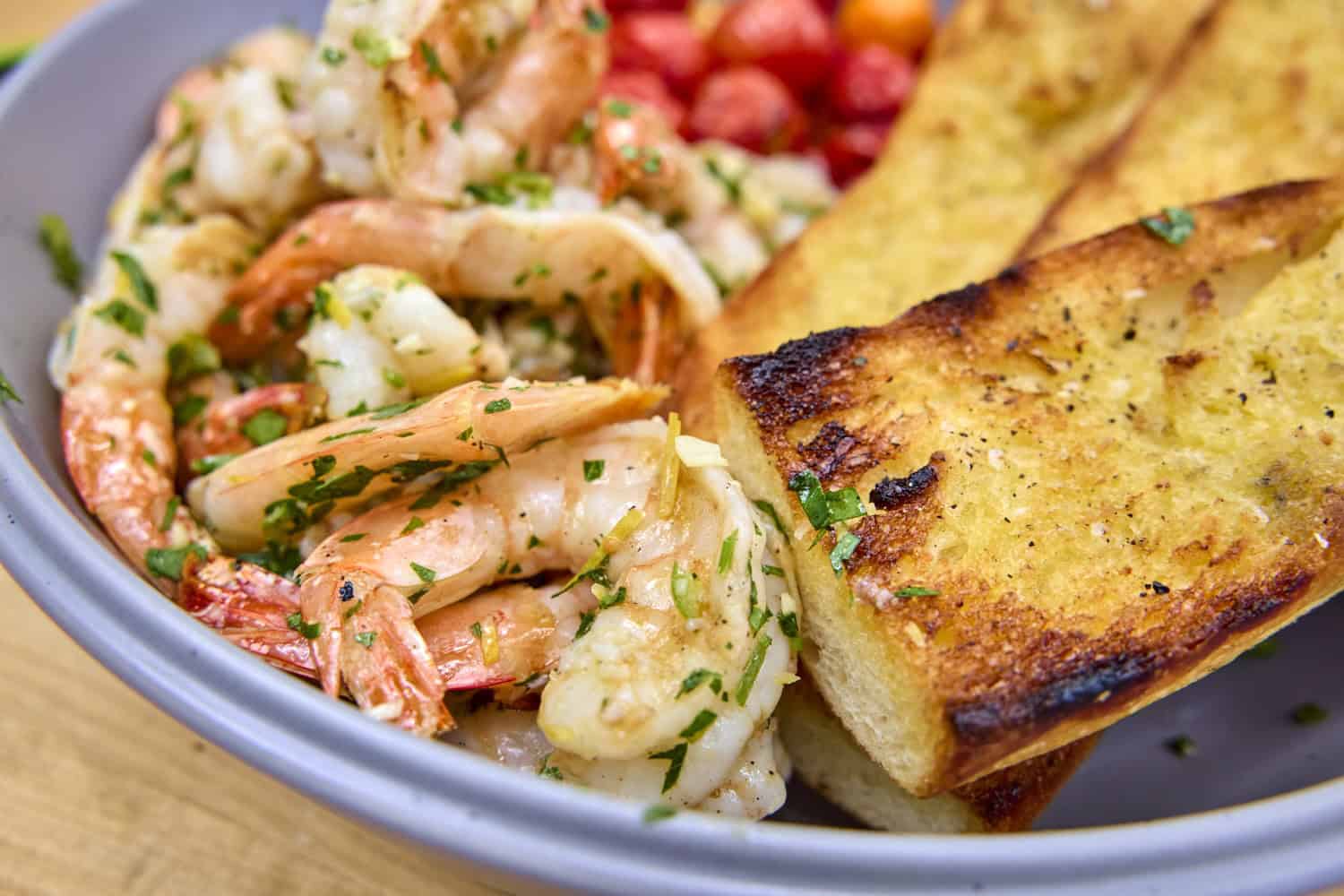
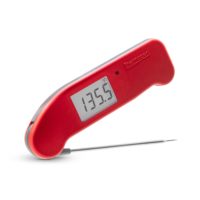
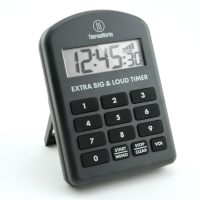
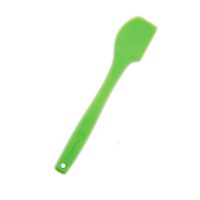
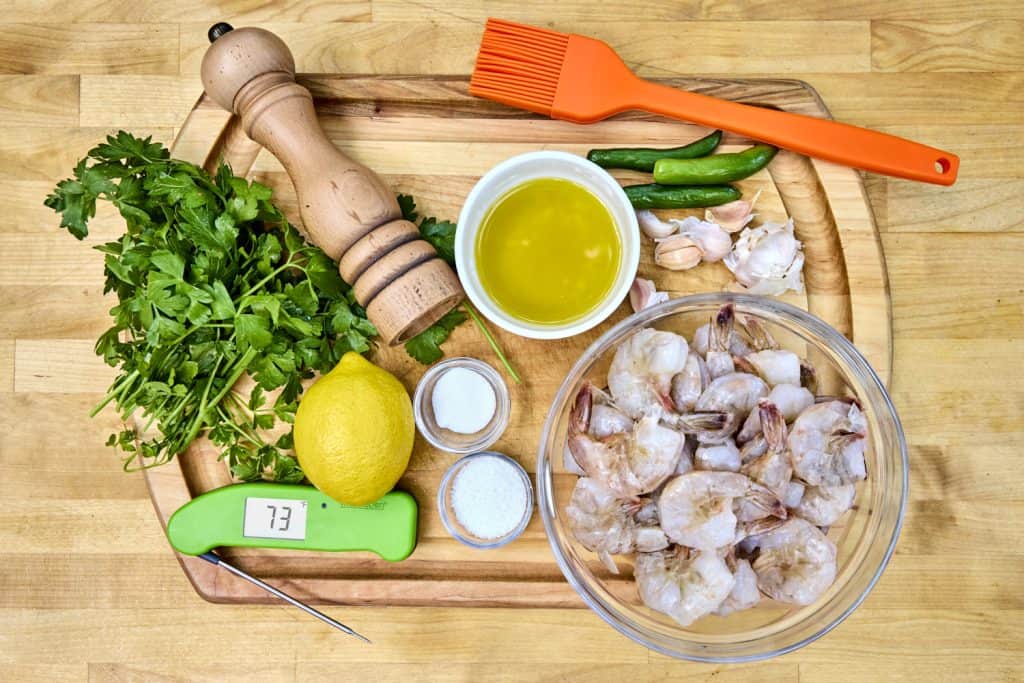
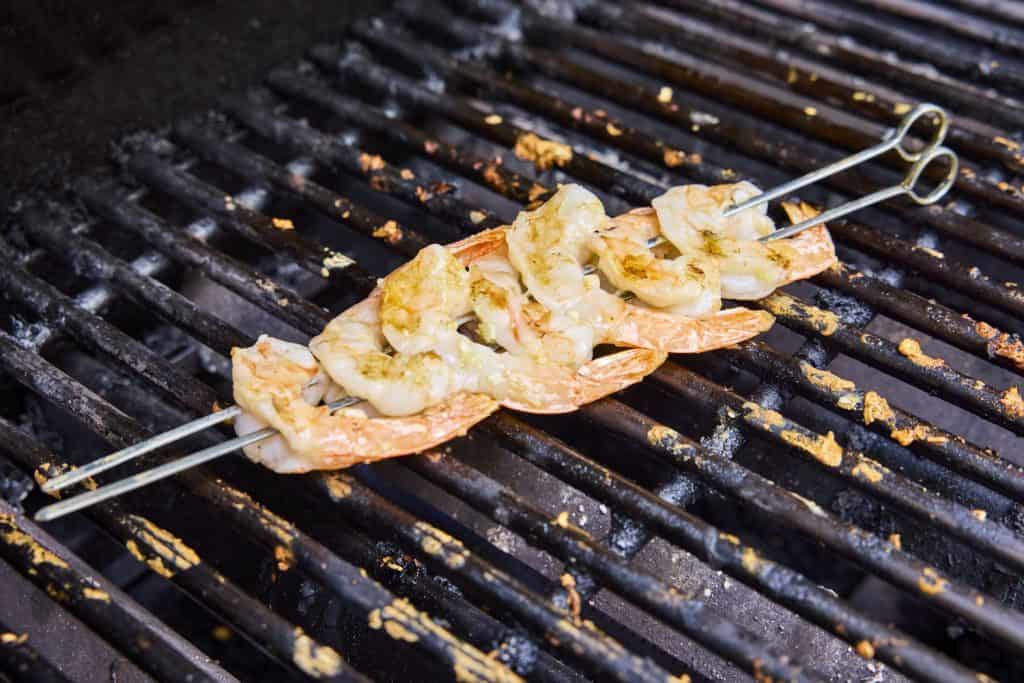
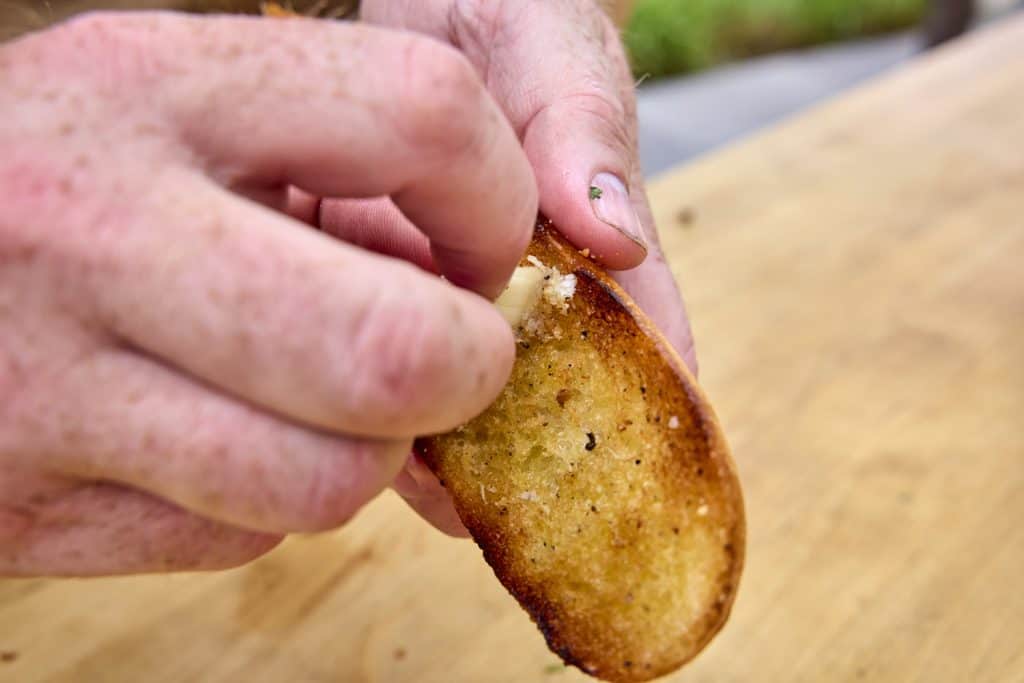
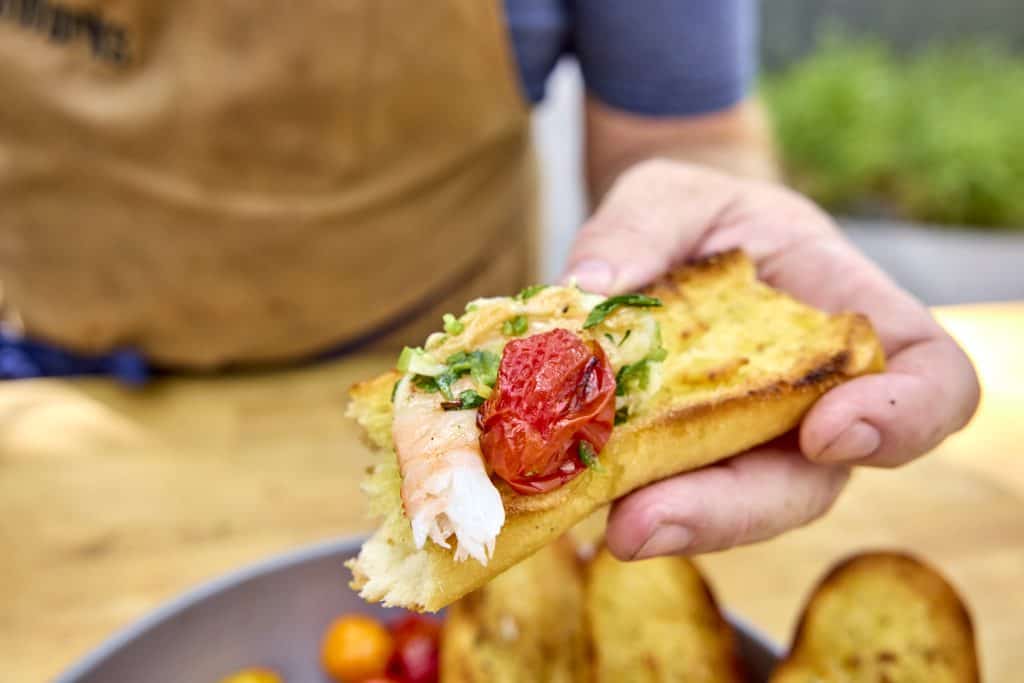
This us an excellent thesis on grilling shrimp. Thank you
Grilled Shrimp
Great stuff, keep the recipes coming, in fact you should do a book!…thanks
This reads like Gospel, I can’t wait to try it out!
Great piece. Can’t wait to try this!
A really great technique. Our shrimp are beautiful. Thanks!
Fantastic!
This post really gets the job done. I learned a lot!
Excellent write-up on grilling shrimp. I learned a few things to try, like the sugar and baking soda trick.
Any suggestions on how to keep the shrimp warm for a short time before serving? Yes I know in an ideal world it’s best to cook and eat immediately, but when cooking for a party, sometimes timing isn’t perfect.
Put them in a lidded glass dish and wrap it in towels or put them in a small drink cooler with the lid closed.